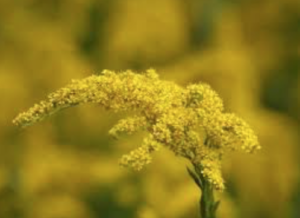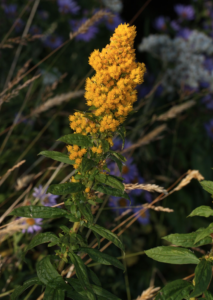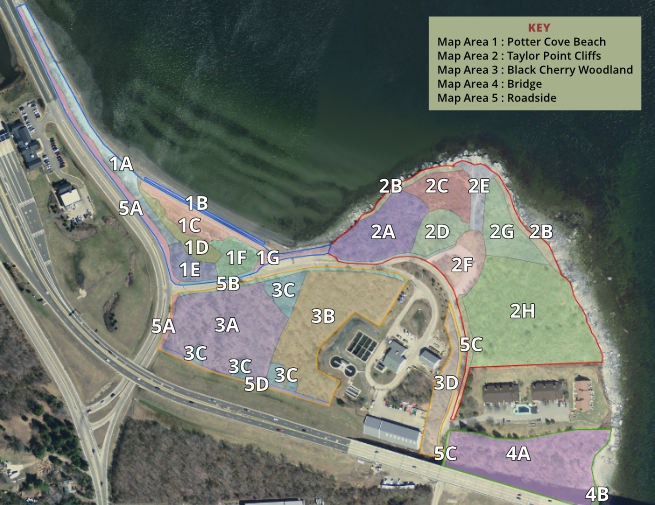Common Name: Seaside Goldenrod
Specific Name: Solidago sempervirens
Known Occurrence at Taylor Point:
Map Areas: Beach 1A, Beach 1C, Cliffs 2B Cliffs 2D
Category: Native, Herbaceous Plant

Ecological Considerations:
Solidago sempervirens, commonly known as Seaside Goldenrod, is a late-flowering, short-day perennial that may grow up to 6 or even 8 feet tall. It blooms from August through October, producing terminal flowering heads with densely clustered spikes of bright yellow flowers. After blooming, flower clusters mature into seed heads filled with fuzzy, nut-like fruit capsules that each contain one seed. The wind disperses the seeds. The seeds require no cold stratification for germination.
Seaside Goldenrod’s dark green leaves are somewhat succulent, oblong, and lance-shaped and are arranged alternately along the entire length of the stem. The edges of the leaf blades have no teeth or lobes. Distinctive, these waxy, fleshy leaves help the plant retain water and are an adaptation to the drying effects of salt spray. The leaves at the base are the largest, and may grow up to 8 in long and 1⁄2 –1 1⁄2 in wide, gradually decreasing in size towards the top of the plant.
Seaside Goldenrod is easily identifiable in winter, recognizable by its whitened leaves, coarse stalks, and dried flower parts. Red leaves sprout in late February and early March, soon turning dark green.
Seaside goldenrod is well adapted to coastal habitats and is tolerant of high salinity and salt spray. It is often found in transition areas alongside other native dune plants such as coastal panicgrass (Panicum amarum), switchgrass (Panicum virgatum), salt meadow cordgrass (Spartina patens), and American beachgrass (Ammophila breviligulata). It grows well in full sun and dry to average soil and grows well along heavily salted roadways.
Seaside Goldenrod also has been used successfully for sand dune stabilization and erosion control. Its stems arise from short hardy rhizomes and its roots extend 14 inches or more, thus holding the sand or soil substrate.
Map areas where this plant can be used for revegetation:
Propagation Mechanisms/Strategies for Encouraging its Establishment:
Seaside goldenrod may be propagated by seed or division. A favored method of establishing seed production plots and dune restoration plantings is with containerized stock transplanted in late winter to early spring.
Best Planting Practices/Options and Pros and Cons of Options:
Key Issues Regarding its Ecology:
Associated Ecological Benefits:
The flowers of Seaside Goldenrod are an important food/energy source for fall migrating monarch butterflies traveling the Atlantic coastal flyway. It is also an important resource for over-wintering, gall-producing insects, such as some species of predatory wasps. In addition, gall larvae provide an excellent winter food source for birds such as the chickadee and woodpecker and it provides food and shelter for butterflies, birds, and small mammals.
Availability of Locally Sourced Seeds and Plants:
Case Studies of Native Plant Establishment Efforts/Lessons Learned:
Additional Photos:



Sources cited:
Go Botany
USDA
Chesapeakebay.net
Key Words:
Solidago sempervirens
Seaside Goldenrod
Beach 1A
Beach 1C
Cliffs 2B
Cliffs 2D
